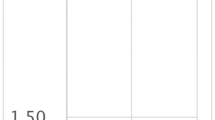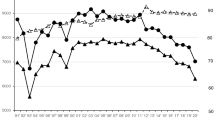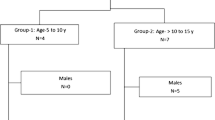Abstract
To explore the prevalence of hematuria or proteinuria in school children in Shanghai and to evaluate the screening methods, we conducted urine screening in more than 40,000 school children between 2003 and 2005. Children were tested with dipsticks read manually (method A) or dipsticks read by machines (method B) combined with a sulfosalicylic acid test or microscopy. Some children were tested once, and others who had abnormal results in the first screening were tested again 2 weeks later. The prevalence of urine abnormalities in the first screening was more than 5.00% and of the second screening about 1.00%. Either method B or testing two urine samples for each child had higher specificity. As to the direct cost, that of screening twice with method A was lower than just screening once with method B. So using method A to screen twice for each child was not only convenient and economical, but also could reduce the false positive rate effectively. More than 10 months of follow-up diagnosed two cases of IgA nephropathy. Asymptomatic chronic renal diseases in school children could be detected through school urine screening. For Shanghai, China, screening twice using method A might be the best choice.

Similar content being viewed by others
References
Ramirez SP, Hsu SI, McClellan W (2003) Taking a public health approach to the prevention of end-stage renal disease: The NKF Singapore program. Kidney Int 63(Suppl 83):S61–S65
Brown WW, Collins A, Chen SC, King K, Molony D, Gannon MR, Politoski G, Keane WF (2003) Identification of persons at high risk for kidney disease via targeted screening: The NKF kidney early evaluation program. Kidney Int 63(Suppl 83):S50–S55
Lin CY, Sheng CC, Chen CH, Lin CC, Chou P (2000) The prevalence of heavy proteinuria and progression risk factors in children undergoing urinary screening. Pediatr Nephrol 14:953–959
Yanagihara T, Hayakawa M, Yoshida J, Tsuchiya M, Morita T, Murakami M, Fukunaga Y (2005) Long-term follow-up of diffuse membranoproliferative glomerulonephritis type I. Pediatr Nephrol 20:585–590
Iitaka K, Moriya S, Nakamura S, Tomonaga K, Sakai T (2002) Long-term follow-up of type III membranoproliferative glomerulonephritis in children. Pediatr Nephrol 17:373–378
Kawasaki Y, Suzuki J, Nozawa R, Suzuki H (2002) Efficacy of school urinary screening for membranoproliferative glomerulonephritis type 1. Arch Dis Child 86:21–25
Murakami M, Yamamoto H, Ueda Y, Murakami K, Yamauchi K (1991) Urinary screening of elementary and junior high-school children over a 13-year period in Tokyo. Pediatr Nephrol 5:50–53
Yamagata K, Takahashi H, Suzuki S, Mase K, Hagiwara M, Shimuzu Y, Harayama K, Kobayashi M, Narita M, Koyama A (2004) Age distribution and yearly changes in the incidence of ESRD in Japan. Am J Kidney Dis 43:433–443
Murakami M, Hayakawa M, Yanagihara T, Hurunaga Y (2005) Proteinuria screening for children. Kidney Int 67(s94):s23–s27
Gao GD, Peng NN, Zhou YF, Zhu W, Chen SD, Yang ZM, Zhao DM (2000) The analysis of dropping out because of sickness and death in Shanghai students. Shanghai Journal of Preventive Medicine 12:514–515
Dodge WF, West EF, Smith EH, Bruce Harvey 3rd (1976) Proteinuria and hematuria in schoolchildren: epidemiology and early natural history. J Pediatr 88:327–347
Vehaskari VM, Rapola J, Koskimies O, Savilahti E, Vilska J, Hallman N (1979) Microscopic hematuria in school children: epidemiology and clinicopathologic evaluation. J Pediatr 95:676–684
National Association of Pediatric Nephrology (1988) The epidemiology investigation of children urinary tract diseases. Chinese Pediatric Magazine 27:304
Park YH, Choi JY, Chung HS, Koo JW, Kim SY, Namgoong MK, Park YS, Yoo KH, Lee KY, Lee DY, Lee SJ, Lee JE, Chung WY, Hah TS, Cheong HI, Choi Y, Lee KS (2005) Hematuria and proteinuria in a mass school urine screening test. Pediatr Nephrol 20:1126–1130
Assadi FK (2005) Value of urinary excretion of microalbumin in predicting glomerular lesions in children with isolated microscopic hematuria. Pediatr Nephrol 20:1131–1135
Lin CY, Hsieh CC, Chen WP, Yang LY, Wang HH (2001) The underlying diseases and follow-up in Taiwanese children screened by urinalysis. Pediatr Nephrol 16:232–237
Boulware LE, Jaar BG, Tarver-Carr ME, Brancati FL, Powe NR (2003) Screening for proteinuria in US adults a cost effectiveness analysis. JAMA 290:3101–3114
Acknowledgement
We thank the Shanghai Health Bureau, Xu Hui District Health Bureau, and school doctors and medical members for their cooperation in this study.
Author information
Authors and Affiliations
Corresponding author
Rights and permissions
About this article
Cite this article
Zhai, YH., Xu, H., Zhu, GH. et al. Efficacy of urine screening at school: experience in Shanghai, China. Pediatr Nephrol 22, 2073–2079 (2007). https://doi.org/10.1007/s00467-007-0629-5
Received:
Revised:
Accepted:
Published:
Issue Date:
DOI: https://doi.org/10.1007/s00467-007-0629-5




